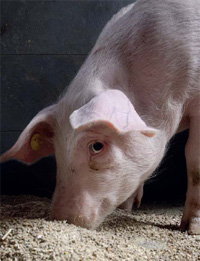Pig feed: Potential effects of antimicrobial carryover

Medicated feed premixes are often included in compound feeds. Hence, some antibiotic carryover can occur when a feed miller switches from producing one feed type to the other. What levels would be acceptable and is it known what effects this may have?
Following the recent Dutch comments by their Ministry of Economics, Agriculture and Innovation to reduce the use of antibiotics in agriculture by 50% by 2013, one of the measures included the possibility of banning the use of medicated feed premixes. In addition, the risk from carryover of antimicrobials in feed to other supposedly non-medicated feed was also thought to pose an additional hazard by the possible induction of antimicrobial resistance in commensal bacteria such as Escherichia coli or Enterococcus species and potentially zoonotic bacteria, such as Campylobacter spp, which cause food poisoning in humans.
Personally, I was rather dismissive that a carryover of 3% or less might pose any sort of risk but I felt that it might be worth looking at the potential risks that might be involved. As a result I decided to look at normal pig premix inclusion levels for common antimicrobials. Where data was not available, a model was used to assess gut contents concentration that might be achieved in the small intestine and colon (Burch, 2007), and compare them with their minimum inhibitory concentrations (MICs) against the bacteria found in pigs’ intestines as was recently reported in Maran (2010) with Dutch isolates.
Antimicrobial susceptibility patterns
The colonic contents concentration was either available from references or were derived using a basic model. The small intestinal contents concentration (SICC) was estimated at 25% of the colon contents or faecal concentration (CCC).
For antibiotics, which were active against porcine E. coli and Campylobacter coli, examples of commensal and potentially zoonotic bacteria respectively, the susceptibility patterns were taken from Maran 2008 (2010).For antibiotics, which were not active against E. coli, like the macrolide, Tylosin, the Enterococcus spp results were used (E. faecalis and E. faecium) as well as C. coli. Unfortunately, the individual porcine results were not reported for the two Enterococci species but only all animal species, including isolates from pigs, broilers and cattle.
Antimicrobial comparisons
Tetracyclines (chlortetracycline)
Tetracyclines (chlortetracycline)
The tetracyclines are the most commonly used antibiotics in pig feed in the EU, mainly for respiratory disease control but also for ileitis control. The faecal concentration of chlortetracycline was described by Hansen and others in 2002. In the UK, 400 ppm chlortetracycline is the common inclusion level and the estimated colon concentration of 56 µg/g was used in the calculations (see Table 1 and Figure 1).
The colon contents concentration at 3% carryover might have an impact on a very small number of isolates of both E. coli and C. coli but the small intestinal contents concentration should have no effect. Chlortetracycline can act in an anaerobic (no oxygen) environment, as found in the colon. There is already a substantial amount of resistance observed to chlortetracycline (>70%) by both organisms above the clinical breakpoint of 56µg/g, when 400ppm chlortetracycline is used. This pattern highlights that therapeutic use is far more significant at resistance induction than carryover.
Beta-Lactams (Ampicillin/amoxycillin)
Amoxycillin is commonly administered in feed at 400ppm for the treatment of Streptococcus suis in pigs, which causes meningitis and also arthritis. It is absorbed from the gut (approximately 30%) and potentially substantial quantities can pass down into the colon contents. No published data was available on gut concentrations, so a ‘worst case’ scenario of 70% was used in the calculations. It may also concentrate in the colon and be active in this anaerobic (no oxygen) environment.
It was found that amoxycillin concentrations in the colon could exert an effect on a number of susceptible isolates of both E. coli and C. coli, providing there is no major binding or extensive breakdown of the drug on its passage down the intestine, like ordinary penicillin. The small intestine concentration at the 3% carryover could also have a minor impact.
Aminoglycosides (Neomycin/Kanamycin)
Neomycin was commonly used at 220ppm for the control of post-weaning diarrhoea in piglets, caused by E. coli. It is very similar in its mode of action and resistance development to Kanamycin, which was used in Maran (2010). It is poorly absorbed from the gut (<10%) so a figure of 90% is used in the model. It does not take into account any breakdown or binding in the gut. It is not active in an anaerobic environment so small intestine contents concentrations are probably more representative.
The small intestinal contents concentration would have no expected effect against E. coli, at a 3% carryover but could potentially have quite a marked effect on C. coli. However, the incidence of clinical resistance is relatively small in comparison with other antimicrobials routinely used in pig medicine.
Sulphonamides (Sulphamethoxazole)
Sulphonamides are rarely used on their own in pigs but usually in combination with trimethoprim. Unfortunately, there is no combined MIC data available in Maran (2010). Sulphamethoxazole is commonly used at 250ppm and is well absorbed (90%) so only approximately 10% will pass down the intestines into the colon.
The colon contents and small intestine contents concentrations are well below the MICs for both E. coli and C. coli. It is therefore considered that they will have no effect on selection for antimicrobial resistance at a 3% carryover.
Macrolides (erythromycin; tylosin)
Erythromycin is used in the Maran (2010) report as the representative of the Macrolide family, which includes the widely used antibiotic Tylosin, for the treatment of ileitis caused by Lawsonia intracellularis and enzootic pneumonia caused by Mycoplasma hyopneumoniae. Recent gut concentration data is available from Karanikolova and others (2010) adjusting the dose for the right inclusion rate of 100ppm, concentrations in the colon contents were estimated at 38.2µg/g and in the ileum (the terminal part of the small intestine) 14.2µg/g (see Table 2 and Figure 2).
The ileal contents concentration at 3% carryover is below the recorded MICs. As Tylosin is anaerobically active, the colon contents concentration is probably the most representative but this would appear to have only a minor effect on a few isolates of Enterococci and C. coli. This also assumes that all of the drug concentration is bioavailable and not bound to the contents at all.
Conclusions
It is considered that soluble Sulphonamides that are regularly used with Trimethoprim are unlikely to have an impact on both E. coli and C. coli. Neomycin could have a possible effect on C. coli isolates but resistance is not a major issue, suggesting the mode of action of the drug only induces resistance at a low rate. In many countries of the EU neomycin in feed is now not available. In comparison Chlortetracycline resistance is widespread for both E. coli and C. coli and carryover of 3% might have only a very minor impact on resistance selection in comparison with therapeutic use. Amoxycillin does have the potential to select for both E. coli and C. coli resistance, based on model data as it concentrates in the colon. Other beta-lactam antibiotics, like Penicillin G, are very unstable in the gut and disappear in the colon, so further work is required to develop more definitive data. Tylosin would appear to be of low risk at 3% of the recommended inclusion rate in feed.
It can be concluded that generally a 3% carryover, similar to the tolerance carryover limit for anticoccidials approved by EFSA, is unlikely to result in major resistance development in comparison with regular therapeutic use. However, there is a possibility that some antibiotics, such as amoxycillin, even at low concentrations might have an impact. It is recommended that further work to determine more accurately concentrations achieved in the gut is carried out before final conclusions and recommendations can be made. Possibly tighter carryover restrictions might need to be imposed on some antibiotics, down to 1% as they are with some anticoccidials.











